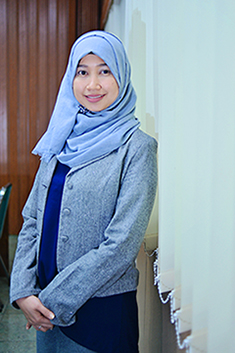Formulation and Characterization of Instant Powder Combination of Ginger, Bangle, and Lemon Extract as an Antioxidant
Downloads
Background: Degenerative disease is a decreasing organ function; clinical manifestations can affect the whole body, which is caused by oxidative stress. Ginger, bangle, and lemon have antioxidant properties. The combination of the three is expected to increase antioxidant activity. Objective: This study aimed to determine the potential antioxidant activity of the mixture of the three samples formulated as instant powder. Methods: This research is an experimental laboratory. This study will examine the effect of variations in extract concentration and PEG-40 HCO concentration on instant powder's characteristics and antioxidant activity. Results: Individually, ginger extract has extreme antioxidant activity (IC50 = 23.57 ± 0.13 µg/mL) and bangle strong (IC50 = 64.89 ± 0.15 µg/mL), while lemon has weak antioxidant activity (IC50 >500 µg/mL). Combining ginger, bangle, and lemon with a simplex axial method obtained the combination of ginger: bangle: lemon with the ratio of 4/6: 1/6: 1/6. Adding a mixture of extracts affects the solubility and antioxidant activity of the extracts. The greater the amount of extract, the lower the solubility, and the antioxidant activity did not increase with addition. The addition of PEG-40 HCO increases the solubility of the extract in the instant powder. Antioxidant activity increased to the "medium” category (121.90 µg/mL) after adding PEG-40 HCO at a concentration of 2.70%. The unfavourable impact of PEG-40 HCO addition on instant powders is the angle of repose, flow time, and compressibility. Conclusion: The ginger, bangle, and lemon can be combined and made into instant powder with potential antioxidant activity in the moderate category.
Abdassah, M. (2017). Nanoparticles with Ionic Gelation. Farmaka; 15; 45–52. doi: 10.24198/jf.v15i1.12138.
Abdullah, H. S. & Imtihani, H. N. (2022). Formulation and Evaluation of Solid Dispersion Granules of Mangrove Crab (Scylla serrata) Shell Chitosan Extracts With Chitosan: PVPK-30 1:2. Jurnal Kefarmasian Akfarindo; 7; 45–51. doi: 10.37089/jofar.vi0.119.
Ahmed, N., Karobari, M. I., Yousaf, A., Mohamed, R. N., Arshad, S., Basheer, S. N., Peeran, S. W., Noorani, T. Y., Assiry, A. A. & Alharbi, A. S. (2022). The Antimicrobial Efficacy Against Selective Oral Microbes, Antioxidant Activity and Preliminary Phytochemical Screening of Zingiber officinale. Infection and Drug Resistance; 15; 2773–2785. doi: 10.2147/IDR.S364175.
Aji, N., Kumala, S., Mumpuni, E. & Rahmat, D. (2022). Antibacterial Activity and Active Fraction of Zingiber Officinale Roscoe, Zingiber montanum (J. Koenig) Link ex A., and Zingiber zerumbet (L.) Roscoe ex Sm. Against Propionibacterium acnes. Pharmacognosy Journal; 14; 103-111. doi: 10.5530/pj.2022.14.15.
Aji, N., Kumala, S., Mumpuni, E. & Rahmat, D. (2023). Comparison of Sunscreen and Antioxidant Activities: 70% And 96% Ethanol Extract From Bangle (Zingiber montanum (J. Koenig) Link ex A.,) Rhizome. Medical Sains: Jurnal Ilmiah Kefarmasian; 8; 605–614. doi: 10.37874/ms.v8i2.557.
Aji, N., Puspitasari, A., Nafisah, H. & Armilda, L. H. V. (2023). Antioxidant and Anti-Propionibacterium acnes Activities of Citronella Oil and Clove Oil, and Their Formulation Into Emulgel. Pharmaceutical Journal of Indonesia; 20; 64–70. doi: 10.30595/pharmacy.v0i0.12629.
Asencio, A. D., Serrano, M., García-Martínez, S. & Pretel, M. T. (2018). Organic Acids, Sugars, Antioxidant Activity, Sensorial and Other Fruit Characteristics of Nine Traditional Spanish Citrus Fruits. European Food Research and Technology; 244; 1497–1508. doi: 10.1007/s00217-018-3064-x.
Cavalcanti, V. P., Aazza, S., Bertolucci, S. K. V., Rocha, J. P. M., Coelho, A. D., Oliveira, A. J. M., Mendes, L. C., Pereira, M. M. A., Morais, L. C. & Forim, M. R. (2021). Solvent Mixture Optimization in The Extraction of Bioactive Compounds and Antioxidant Activities From Garlic (Allium sativum L.). Molecules; 26; 60-26. doi: 10.3390/molecules26196026.
Cerdá, B., Marhuenda, J., Arcusa, R., Villaño, D., Ballester, P. & Zafrilla, P. (2022). Ginger in the Prevention of Cardiovascular Diseases. Functional Food; 14; 943-959. doi: 10.5772/intechopen.98161.
Çopur, Ö. U., Ä°ncedayı, B. & Karabacak, A. Ö. (2019). Technology and Nutritional Value of Powdered Drinks: Production and Management of Beverages. Cambridge: Elsevier. doi: 10.1016/B978-0-12-815260-7.00002-X.
Cornell, J. A. (2011). Axial Design: A Primer on Experiments with Mixtures. Florida: John Wiley & Sons.
DepKes RI. (2000). Metode Ekstraksi: Parameter Standar Umum Ekstrak Tanaman Obat. Jakarta: Departemen Kesehatan Republik Indonesia.
Farnsworth, N. R. (1966). Biological and Phytochemical Screening of Plants. Journal of Pharmaceutical Sciences; 55; 225–276. doi: 10.1002/jps.2600550302.
Fridalni, N., Minropa, A., & Sapardi, V. S. (2019). Early Recognition of Degenerative Diseases. Jurnal Abdimas Saintika; 1; 129–135. doi: 10.4161/cc.23067.
Ghafoor, K., Al Juhaimi, F., Özcan, M. M., Uslu, N., Babiker, E. E. & Mohamed Ahmed, I. A. (2020). Total Phenolics, Total Carotenoids, Individual Phenolics and Antioxidant Activity of Ginger (Zingiber officinale) Rhizome as Affected by Drying Methods. LWT - Food Science and Technology; 126; 109-354. doi: 10.1016/j.lwt.2020.109354.
Hanani, E. (2015). Identifikasi Fenol, Tanin, Flavonoid, Alkaloid, Saponin, Steroid dan Triterpenoid: Analisis Fitokimia. Jakarta: Penerbit Buku Kedokteran EGC.
Harun, N. & Rahmawati, K. A. (2022). The Antioxidant Activity of Extract Combination Juice Ginger Rhizome, Turmeric, Galangal And Kaempferia Galanga. Jurnal Kesehatan Bakti Tunas Husada: Jurnal Ilmu Ilmu Keperawatan, Analis Kesehatan Dan Farmasi; 22; 8–14. doi: 10.36465/jkbth.v22i1.893.
Hassan, M., Adhikari-Devkota, A., Imai, T. & Devkota, H. P. (2019). Zerumbone and Kaempferol Derivatives from the Rhizomes of Zingiber montanum (J. Koenig) Link ex A. Dietr. from Bangladesh. Separations; 6; 10-31. doi: 10.3390/separations6020031.
Hudha, M. & Widyaningsih, T. D. (2015). Effervescent Powder Based on Beluntas Leaf Extract (Pluchea indica Less) as a Natural Antioxidant Source. Jurnal Pangan Dan Agroindustri; 3; 1412–1422. doi: 10.21776/jpa.v3i4.264.
Husni, P., Fadhiilah, M. L. & Hasanah, U. (2020). Formulation and Physical Stability Test of Instant Granules of Genjer (Limnocharis flava (L.) Buchenau.) Dry Powder as a Fiber Adding Supplement. Jurnal Ilmiah Farmasi Farmasyifa; 3; 1–8. doi: 10.29313/jiff.v3i1.5163.
Islam, A., Acıkalın, R., Ozturk, B. & Aglar, E., (2022). Effects of Aloe vera Gel and Modified Atmosphere Packaging Treatments on Quality Properties and Bioactive Compounds of Plum (Prunus salicina L.) Fruit Throughout Cold Storage and Shelf Life. Erwerbs-Obstbau; 65; 71-82. doi: 10.1016/j.postharvbio.2022.111855.
Julizan, N. (2019). Validation of Antioxidant Activity Determination by DPPH Methode. Kandaga–Media Publikasi Ilmiah Jabatan Fungsional Tenaga Kependidikan; 1; 1-8. doi: 10.24198/kandaga.v1i1.21473.
Kabkrathok, P., Jarussophon, S., Unger, O., Lomarat, P., Reutrakul, V., Pittayanurak, P., Bongcheewin, B., & Anantachoke, N. (2022). Mass Spectral Analysis of Secondary Metabolites From Zingiber montanum Rhizome Extract Using UHPLC"HR"ESI"QTOF"MS/MS. Phytochemical Analysis; 33; 57–71. doi: 10.1002/pca.3068.
Kadian, R. & Nanda, A. (2022). A Comprehensive Insight on Self Emulsifying Drug Delivery Systems. Recent Advances in Drug Delivery and Formulation: Formerly Recent Patents on Drug Delivery & Formulation; 16; 16–44. doi: 10.2174/2667387815666211207112803.
Kemenkes RI. (2017). Uji Fenol Total, Kurkuminoid Total dan Flavonoid Total: Farmakope Herbal Indonesia Edisi 2 (2nd ed.). Jakarta: Kementerian Kesehatan Republik Indonesia.
Kharat, M., Du, Z., Zhang, G. & McClements, D. J. (2017). Physical and Chemical Stability of Curcumin in Aqueous Solutions and Emulsions: Impact of pH, Temperature, and Molecular Environment. Journal of Agricultural and Food Chemistry; 65; 1525–1532. doi: 10.1021/acs.jafc.6b04815.
Kusumo, N. N., & Mita, S. R. (2018). Review: Effect of Natural Binder on Paracetamol Granulation Results. Farmaka; 14; 228–235. doi: 10.24198/jf.v14i1.10777.
Manju, S. & Sreenivasan, K. (2011). Conjugation of Curcumin onto Hyaluronic Acid Enhances its Aqueous Solubility and Stability. Journal of Colloid and Interface Science; 359; 318–325. doi: 10.1016/j.jcis.2011.03.071.
Martemucci, G., Costagliola, C., Mariano, M., D'andrea, L., Napolitano, P. & D'Alessandro, A. G. (2022). Free Radical Properties, Source and Targets, Antioxidant Consumption and Health. Oxygen; 2; 48–78. doi: 10.3390/oxygen2020006.
Martínez-Guerra, J., Palomar-Pardavé, M., Romero-Romo, M., Corona-Avendaño, S., Rojas-Hernández, A., & Ramírez-Silva, M. T. (2019). New Insights on The Chemical Stability of Curcumin in Aqueous Media at Different pH: Influence of The Experimental Conditions. International Journal of Electrochemical Science; 14; 5373–5385. doi: 10.20964/2019.06.24.
Mehrabi, M., Gardy, J., Talebi, F. A., Farshchi, A., Hassanpour, A. & Bayly, A. E. (2023). An Investigation of The Effect of Powder Flowability on The Powder Spreading in Additive Manufacturing. Powder Technology; 413; 117-997. doi: 10.1016/j.powtec.2022.117997.
Muflihah, Y. M., Gollavelli, G. & Ling, Y.-C. (2021). Correlation Study of Antioxidant Activity With Phenolic and Flavonoid Compounds in 12 Indonesian Indigenous Herbs. Antioxidants; 10; 1530. doi: 10.3390/antiox10101530.
Nhu-Trang, T.-T., Nguyen, Q.-D., Cong-Hau, N., Anh-Dao, L.-T. & Behra, P. (2023). Characteristics and Relationships Between Total Polyphenol and Flavonoid Contents, Antioxidant Capacities, and The Content of Caffeine, Gallic Acid, and Major Catechins in Wild/Ancient and Cultivated Teas in Vietnam. Molecules; 28; 34-70. doi: 10.3390/molecules28083470.
Nikolaeva, T. N., Lapshin, P. V, & Zagoskina, N. V. (2022). Method for Determining the Total Content of Phenolic Compounds in Plant Extracts with Folin–Denis Reagent and Folin–Ciocalteu Reagent: Modification and Comparison. Russian Journal of Bioorganic Chemistry; 48; 1519–1525. doi: 10.1134/S1068162022070214.
Nurkhasanah, N., Sulistyani, N. & Ghifarizi, M. A. (2019). The Effect of Bengle (Zingiber cassumunar Roxb.) Rhizome Chloroform Extract on Nitric Oxide and Reactive Oxygen Intermediate Secretions in Vitro. Ahmad Dahlan International Conference Series on Pharmacy and Health Science (ADICS-PHS 2019); 1; 100–104. doi: 10.2991/adics-phs-19.2019.9.
Odinga, E. S., Waigi, M. G., Gudda, F. O., Wang, J., Yang, B., Hu, X., Li, S. & Gao, Y. (2020). Occurrence, Formation, Environmental Fate and Risks of Environmentally Persistent Free Radicals in Biochars. Environment International; 134; 105-172. doi: 10.1016/j.envint.2019.105172.
Quispe, C., Herrera-Bravo, J., Javed, Z., Khan, K., Raza, S., Gulsunoglu-Konuskan, Z., Daştan, S. D., Sytar, O., Martorell, M., Sharifi-Rad, J. & Calina, D. (2022). Therapeutic Applications of Curcumin in Diabetes: A Review and Perspective. BioMed Research International; 2022; 1-14. doi: 10.1155/2022/1375892.
Rachmawati, H., Novel, M. A., Ayu, S., Berlian, G., Tandrasasmita, O. M., Tjandrawinata, R. R. & Anggadiredja, K. (2017). The In Vitro–In Vivo Safety Confirmation of PEG-40 Hydrogenated Castor Oil as a Surfactant For Oral Nanoemulsion Formulation. Scientia Pharmaceutica; 85; 1-18. doi: 10.3390/scipharm85020018.
Ramadhan, R., Tosepu, R., Phuwapraisirisan, P., Amirta, R., Phontree, K., Firdaus, Y. F. H., Abdulgani, N., Muttaqin, M. Z. & Saparwadi, S. (2022). Evaluation of Non-Timber Forest Products Used as Medicinal Plants From East Kalimantan (Indonesia) to Inhibit Α-Glucosidase and Free Radicals. Biodiversitas Journal of Biological Diversity; 23; 1-8. doi: 10.13057/biodiv/d231102.
Rangel-Yagui, C. de O., Pessoa Jr, A. & Tavares, L. C. (2005). Micellar Solubilization of Drugs. Journal of Pharmaceutical Sciences; 8; 147–163. doi: 10.1208/s12249-008-9057-5.
Rowe, R. C., Sheskey, P. & Quinn, M. (2009). Castor Oil, Hydrogenated: Handbook of Pharmaceutical Excipients Fifth Edition. London: Libros Digitales-Pharmaceutical Press.
Sadiq, I. Z. (2023). Free Radicals and Oxidative Stress: Signaling Mechanisms, Redox Basis For Human Diseases, and Cell Cycle Regulation. Current Molecular Medicine; 23; 13–35. doi: 10.2174/1566524022666211222161637.
Sánchez-Bravo, P., Noguera-Artiaga, L., Martínez-Tomé, J., Hernández, F., & Sendra, E. (2022). Effect of Organic and Conventional Production on The Quality of Lemon "Fino 49.” Agronomy; 12; 9-80. doi: 10.3390/agronomy12050980.
Sarabandi, K., Mahoonak, A. S., & Akbari, M. (2019). Physicochemical Properties and Antioxidant Stability Of Microencapsulated Marjoram Extract Prepared By Co"Crystallization Method. Journal of Food Process Engineering; 42; 1-12. doi: 10.1111/jfpe.12949.
Sari, A. K. & Nurihardiyanti, N. (2023). Increasing the Solubility of Active Pharmaceutical Ingredients With the Micellar Solubilization Method. Pharmaceutical Science Journal; 3; 94–101. doi: 10.52031/phrase.v3i1.508.
Sari, D. J. E. & Widiharti, W. (2021). Implementation of a Healthy Lifestyle as an Effort to Control Concomitant Diseases (COMORBID). Indonesian Journal of Community Dedication in Health (IJCDH); 2; 30–33. doi: 10.30587/ijcdh.v2i01.3128.
Schorsch, C., Wilkins, D. K., Jones, M. G. & Norton, I. (2001). Gelation of Casein-Whey Mixtures: Effects of Heating Whey Proteins Alone or in The Presence of Casein Micelles. Journal of Dairy Research; 68; 471–481. doi: 10.3168/jds.S0022-0302(04)73265-8.
Sirivibulkovit, K., Nouanthavong, S., & Sameenoi, Y. (2018). Based DPPH Assay for Antioxidant Activity Analysis. Analytical Sciences; 34; 795–800. doi: 10.2116/analsci.18P014.
Van, B., Abdalla, A. N., Algarni, A. S., Khalid, A., Zengin, G., Aumeeruddy, M. Z. & Mahomoodally, M. F. (2023). Zingiber officinale Roscoe (Ginger) and its Bioactive Compounds in Diabetes: A Systematic Review of Clinical Studies and Insight of Mechanism of Action. Current Medicinal Chemistry; 31; 887–903. doi: 10.2174/0929867330666230524122318.
Veurink, G., Perry, G., & Singh, S. K. (2020). Role of Antioxidants and a Nutrient Rich Diet in Alzheimer's Disease. Open Biology; 10; 78-84. doi: 10.1098/rsob.200084.
Zamzani, I. & Triadisti, N. (2021). Limpasu Pericarpium: An Altenative Source of Antioxidant From Borneo With Sequential Maceration Method. Jurnal Profesi Medika: Jurnal Kedokteran dan Kesehatan; 15; 60-68. doi: 10.33533/jpm.v15i1.2820.
Zheng, B. & McClements, D. J. (2020). Formulation of More Efficacious Curcumin Delivery Systems Using Colloid Science: Enhanced Solubility, Stability, and Bioavailability. Molecules; 25; 1-25. doi: 10.3390/molecules25122791.
Zheng, B., Zhang, Z., Chen, F., Luo, X. & McClements, D. J. (2017). Impact of Delivery System Type on Curcumin Stability: Comparison of Curcumin Degradation in Aqueous Solutions, Emulsions, and Hydrogel Beads. Food Hydrocolloids; 71; 187–197. doi:10.1016/j.foodhyd.2017.05.022.
Copyright (c) 2023 JURNAL FARMASI DAN ILMU KEFARMASIAN INDONESIA

This work is licensed under a Creative Commons Attribution-NonCommercial-ShareAlike 4.0 International License.
1. The copyright of this journal belongs to the Editorial Board and Journal Manager with the author's knowledge, while the moral right of the publication belong to the author.
2. The formal legal aspect of journal publication accessibility refers to the Creative Commons Attribution-Non-Commercial-Share Alike (CC BY-NC-SA), which implies that the publication can be used for non-commercial purposes in its original form.
3. Every publication (print/electronic) is open access for educational, research, and library purposes. In addition to the objectives mentioned above, the editorial board is not responsible for copyright infringement


.jpg)















